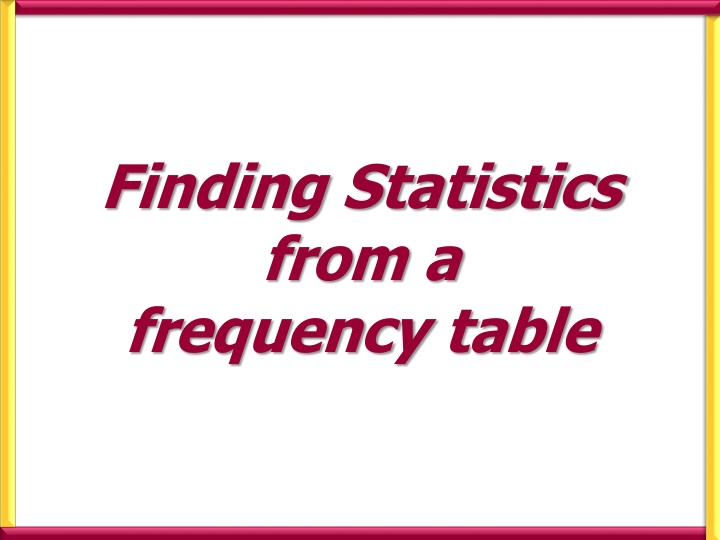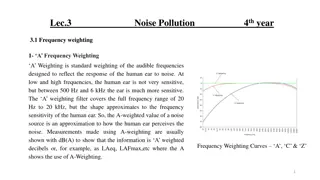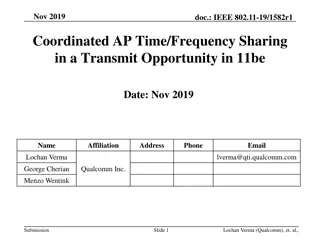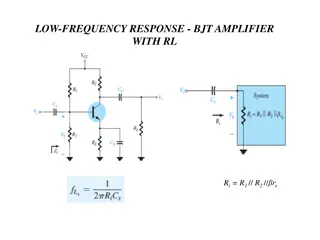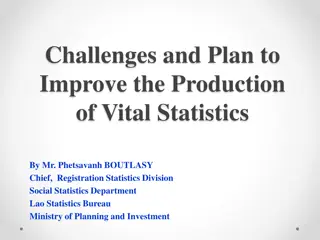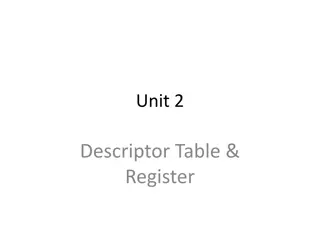Finding Statistics from Frequency Table
A tutorial on finding statistics such as min, max, range, mean, and standard deviation from a frequency table. The example involves a person rolling a die 50 times and recording the results. Learn how to input data, set up the calculator, and perform statistical calculations step-by-step.
Download Presentation

Please find below an Image/Link to download the presentation.
The content on the website is provided AS IS for your information and personal use only. It may not be sold, licensed, or shared on other websites without obtaining consent from the author.If you encounter any issues during the download, it is possible that the publisher has removed the file from their server.
You are allowed to download the files provided on this website for personal or commercial use, subject to the condition that they are used lawfully. All files are the property of their respective owners.
The content on the website is provided AS IS for your information and personal use only. It may not be sold, licensed, or shared on other websites without obtaining consent from the author.
E N D
Presentation Transcript
Finding Statistics from a frequency table
1 person rolled a di 50 times and recorded their rolls. their rolls. 1 person rolled a di 50 times and recorded Number 1 2 3 4 5 6 Find the (i) Min (ii) Max (iii) Range (iv) Mean (v) Standard Deviation Number 1 2 3 4 5 6 Frequency 8 7 13 4 11 7 7 Frequency 8 7 13 4 11 We first need to make sure the calculator is CLeaR of all previous content Find the (i) Min (ii) Max (iii) Range (iv) Mean (v) Standard Deviation from the calculator from the calculator
1 person rolled a di 50 times and recorded their rolls. We first need to make sure the calculator is CLeaR of all previous content Number 1 2 3 4 5 6 Frequency 8 7 13 4 11 7 3: All Yes Reset All Find the (i) Min (ii) Max (iii) Range (iv) Mean (v) Standard Deviation from the calculator
1 person rolled a di 50 times and recorded their rolls. We need to SETUP the calculator to allow us to input Stat with frequency ON Number 1 2 3 4 5 6 Frequency 8 7 13 4 11 7 We need to SETUP the calculator to allow us to input Stat with frequency ON Find the (i) Min (ii) Max (iii) Range (iv) Mean (v) Standard Deviation from the calculator
1 person rolled a di 50 times and recorded their rolls. Statistical and Regression Calculations Number 1 2 3 4 5 6 Frequency 8 7 13 4 11 7 Put the calculator into STAT mode Find the (i) Min (ii) Max (iii) Range (iv) Mean (v) Standard Deviation from the calculator
1 person rolled a di 50 times and recorded their rolls. We only have 1 variable so Select Enter the number column first pressing Number 1 2 3 4 5 6 Frequency 8 7 13 4 11 7 after each one. (the frequency automatically sets to 1) Go to the top of the next column Enter each frequency pressing Find the (i) Min (ii) Max (iii) Range (iv) Mean (v) Standard Deviation from the calculator After each one Once they have all been entered press
1 person rolled a di 50 times and recorded their rolls. Number 1 2 3 4 5 6 Frequency 8 7 13 4 11 7 We now need to analyse the statistics we have input Find the (i) Min (ii) Max (iii) Range (iv) Mean (v) Standard Deviation from the calculator
1 person rolled a di 50 times and recorded their rolls. change the type of data 1: Type 2: Data Edit the data Number 1 2 3 4 5 6 Frequency 8 7 13 4 11 7 3: Sum 4: Var 5: Min and max of x 1: How many terms 2: Mean of data 3: Population Standard Deviation 4: Sample Standard Deviation Find the (i) Min (ii) Max (iii) Range (iv) Mean (v) Standard Deviation from the calculator Once you have chosen your required output you need to press
1 person rolled a di 50 times and recorded their rolls. (i) Min (ii) Max = 0 Number 1 2 3 4 5 6 Frequency 8 7 13 4 11 7 = 6 (iii) Range (iv) Mean = 6 0 = 6 = 3.48 Find the (i) Min (ii) Max (iii) Range (iv) Mean (v) Standard Deviation from the calculator (i) Standard Deviation = 1.66
E.g 1 The frequency table of the monthly salaries of 20 people is shown below. salary(in ) 3500 4000 4200 4300 frequency 5 8 5 2 a) Calculate the mean of the salaries of the 20 people. b) Calculate the standard deviation of the salaries of the 20 people.
E.g 2. The following table shows the grouped data, in classes, for the heights of 50 people. height (in cm) - classes 120 ? < 130 130 ? < 140 140 ? < 150 150 ? < 160 160 ? < 170 frequency 2 5 25 10 8 a) Calculate the mean of the salaries of the 20 people. b) Calculate the standard deviation of the salaries of the 20 people
E.g3. Consider the following three data sets A, B and C. A = {9,10,11,7,13} B = {10,10,10,10,10} C = {1,1,10,19,19} a) Calculate the mean of each data set. b) Calculate the standard deviation of each data set. c) Which set has the largest standard deviation? d) Is it possible to answer question c) without calculations of the standard deviation?
E.g 4.A given data set has a mean and a standard deviation . a) What are the new values of the mean and the standard deviation if the same constant k is added to each data value in the given set? Explain. b) What are the new values of the mean and the standard deviation if each data value of the set is multiplied by the same constant k? Explain. E.g 5 If the standard deviation of a given data set is equal to zero, what can we say about the data values included in the given data set?
